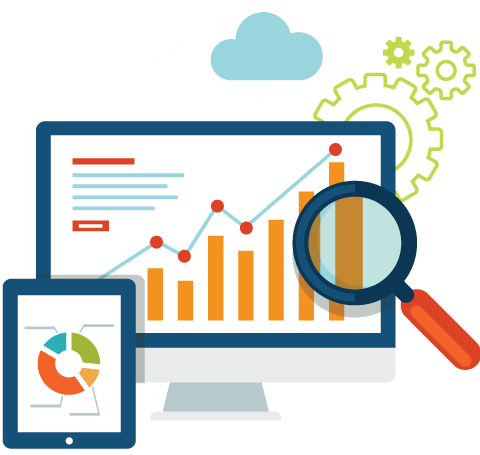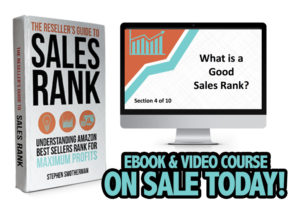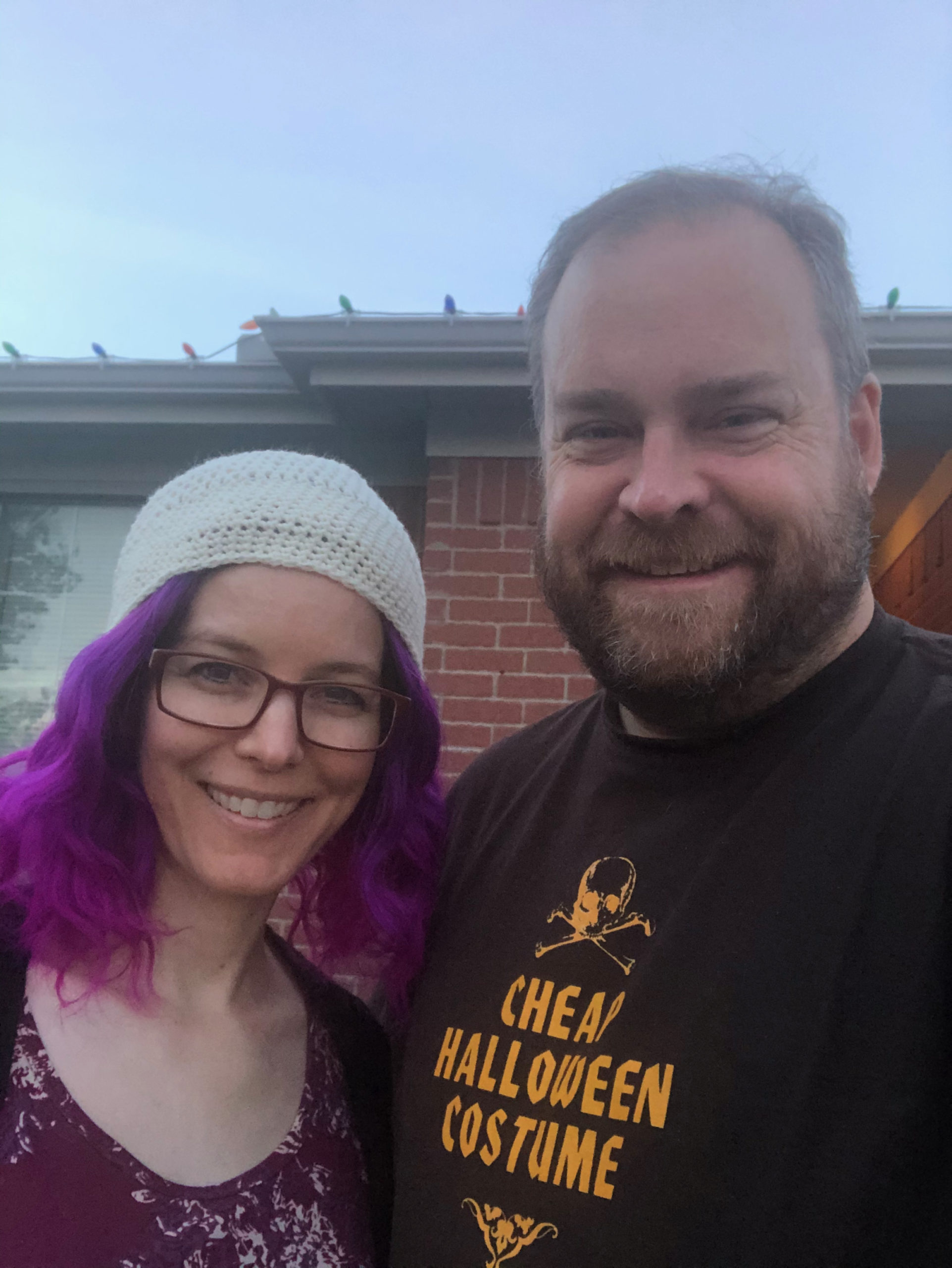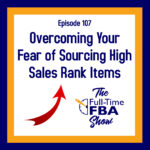As a reseller on Amazon, you’re predominantly going to be looking for low-ranking inventory items to resell. Generally speaking, the lower the rank, the faster the item will sell. For this reason, many people are afraid of buying inventory with a high sales rank.
This week on The Full-Time FBA Show, we bring you the final episode in our October Fear Series, where we discuss the four instances when it may actually be a good idea to buy a high-ranking item to resell on Amazon. We advise you as to how to check the sales rank and pricing history of inventory items, so you can ascertain whether or not it’s a risk you’re willing to take, and we inform you of further resources to better understand what sales rank is and how it works. Tune in today to find out how to overcome your fear of buying high-ranking inventory!
Listen on the podcast player below.
Like what you hear? Tell a friend… and be sure to leave us a rating and a review. Here’s how.
Key points from Episode 107:
 What sales rank is and how important it is.
What sales rank is and how important it is.- The four times it’s worth buying a high-ranking item to resell on Amazon.
- How an item may only have a high ranking because it is out of stock.
- The benefits of Keepa: an app that shows the sales rank and pricing history of an item.
- How an artificially high price may result in a high sales rank.
- Find out how the sales velocity of items improves during Q4.
- How improving the product page of an item may improve its sales rank.
- Key advice on how to improve product pages .
- And more!
Links and resources mentioned in this episode:
- FREEBIE – Monthly updated sales rank chart
- Sales Rank 101
- The Reseller’s Guide to Sales Rank mini-course
- Keepa – Amazon product price and sales rank tracker
- Amazon Advantage – Create or improve Amazon product pages
Right-click here and save as to download this episode to your computer.
 More Episodes from the Full-Time FBA Show podcast:
More Episodes from the Full-Time FBA Show podcast:
Don’t miss an upcoming episode! Subscribe, download episodes, and review the Full-Time FBA Show:
-
-
- Subscribe on iTunes
- Follow on Spotify
- Follow on Amazon Music (or just ask Alexa to “play The Full-Time FBA Show podcast”)
- Follow on iHeartRadio
- Subscribe on Podbean
- Subscribe on Podbay
- Subscribe on Podchaser
-
![]()
 The Reseller’s Guide to Sales Rank
The Reseller’s Guide to Sales Rank
Sales rank is easily the most misunderstood aspect of selling on Amazon. What is a good sales rank? What does a sales rank of zero mean? What do I do with sales rank for sub-categories? Why does sales rank have to be so confusing so much of the time?
I’m here to tell you it doesn’t have to be that way! You can finally get the clarity you need on the issue of understanding Amazon sales rank numbers. We at Full-Time FBA have launched a mini-course called The Reseller’s Guide to Sales Rank: Understanding Amazon Best Sellers Rank for Maximum Profits. The mini-course is a combination ebook (30+ pages) and video course (almost 2 hours).
Check out The Reseller’s Guide to Sales Rank mini-course to see how you can master the concept of best sellers rank and be on your way toward smarter sourcing decisions for your Amazon FBA business!
![]()
Back to the main page for The Full-Time FBA Show
![]()
Episode 107 Transcript:

[PREVIEW]
It’s the last week of October and that means it’s the last week of our Fear Series. We’ve had a little fun this month talking about overcoming your Amazon FBA fears and we’ll do it again next year too. If you have any fears you want to help overcome, be sure to let us know. Let’s get to today’s episode.
[INTRODUCTION]
[0:00:17.0] ANNOUNCER: Welcome to The Full-Time FBA Show. In each episode, it’s our goal to help you turn part-time hours into a full-time income, selling almost anything on Amazon. Now, your hosts of the show, Stephen and Rebecca Smotherman.
[DISCUSSION]
[0:00:36.2] STEPHEN: Welcome to episode number 107 of The Full-Time FBA show. Today, we are finishing up our Fear Series, talking about overcoming your fears of buying inventory that has a high sales rank. To talk with me about that is someone who I rank very highly in my life, Rebecca, how are you doing?
[0:00:54.1] REBECCA: That’s so sweet. I’m doing great.
[0:00:56.5] STEPHEN: I guess, technically, if I say you rank high, that’s a bad thing for Amazon so – you rank really low in my life? That didn’t sound right either.
[0:01:03.5] REBECCA: I should be number one.
[0:01:03.7] STEPHEN: You are number one in my life. Anyway, we’re going to talk about buying high ranking sales rank, we’re going to be talking about high-ranking inventory and some signs it’s a good idea to buy it on today’s episode.
[0:01:19.3] REBECCA: As we alluded to in our little introduction there, most of the time as a reseller on Amazon, you’re going to be looking for inventory items to resell that are low ranking. Usually, the lower the rank, the faster the item is selling. But over the years, we have found that there are about four times when it might be a good idea to buy a high-ranking item for resell on Amazon.
This is just a list that we’ve compiled over the years, our criteria for when we might consider buying a high-ranking item but before we get into that, Stephen, could you give the listener a quick overview of what sales rank is and how important it is?
[0:01:58.3] STEPHEN: Yeah, a little sales rank 101 for you. Sales rank, also known as Amazon bestseller rank, is how Amazon is ranking every inventory item in their catalog and so, the best is number one and it goes down from there. It divides it up into different categories. Usually, the bestseller rank will be within that particular category, you can find it on almost every single Amazon product page, you just kind of scroll down to the ‘product details’ section and you can see it there.
Like we said before, low-ranking items means usually that it’s selling faster, and high-ranking items means slower. Rank is relative to its category, that’s why we put together a sales rank chart for you to see how different sales rank numbers react in relation to the particular category, because a 500,000 sales rank in toys, that’s not very good.
But a 500 sales rank in books, well, that’s pretty good, that’s selling really well. In fact, we have a whole mini course, taking you through everything there is to know about sales rank, you can find that at fulltimefba.com/salesrankcourse. So that’s kind of a little intro. Let’s talk about the four times it’s worth buying a high-ranking item to resell on Amazon.
[0:03:12.4] REBECCA: Okay, the first time that we would consider buying a high-ranking item to resell on Amazon would be if the item is out of stock on Amazon. The way that a sales rank would go down or improve is if it has more sales, if the item has more sales. That sales rank number cannot improve or go lower if there are no sales.
You can’t have sales if the item is out of stock, it’s pretty self-explanatory common sense, but sometimes you might find a hidden gem of an out-of-stock item. You definitely want to check Keepa in this instance.
Keepa is a program that you can use on your smart phone, or you can install it as a Google Chrome extension on your browser if you’re doing research on your computer, and this program will allow you to check out the sales rank history and the pricing history of an item.
If you see an out-of-stock item that you suspect might be a good seller, but it has a high rank, be sure to check out the Keepa data because you might find that, in the past, this item was selling really well but then once it went out-of-stock, that sales rank just kind of crept up higher and higher.
This would be a good indication that it might be worth taking a risk on testing it out, buying some of that item to test out, send into Amazon to resell and see if you can get some sales and you can get that sales rank to lower. Then you know that this is a great item, and you can buy more of it, if possible.
[0:04:36.9] STEPHEN: Yeah, I love finding items that are out-of-stock on Amazon when I’m out sourcing, because, just like Rebecca said, you could find something that’s really great that everyone else is passing over that you could buy to resell for a really nice profit.
A second way that we like to buy high-ranking items to resell on Amazon is when the item’s price is artificially high. I don’t know if you’ve ever done this, but have you ever been out sourcing and you scan an item and you’re like, you’re able to buy it for $10 or whatever, and you’re like, “Oh my goodness, it’s selling for $120, that’s amazing.” But the sales rank is really bad. It’s really, really high, it’s not selling, and it might not be selling because it is just priced way too high. There are other sellers out there hoping and they have their fingers crossed that they could sell it at this high price.
Once again, going back and looking at a Keepa graph to check out the sales rank history and pricing history, you might see that, “Oh, actually, this item sells really well at a much lower price.” If the price is artificially high, that might make the sales rank really high as well. I’ll look into Keepa and see if it’s so profitable selling at the price that it’s sold in the past, then I’ll buy it for resell and be able to get a lower price but still make a profit on it.
[0:05:47.5] REBECCA: All right, the third time that we would consider buying an item to resell that would have a high sales rank, higher than is normally within our sourcing parameters is when Q4 is approaching.
This is very applicable right now, at the time that this episode is dropping in October. When Q4 is here, I mean it actually is here, I say when it’s approaching in October but we’re kind of getting in the Q4 right now, the really high sales velocity period of time is coming up in late November and in December, but when Q4 is on the horizon, that’s when we start expanding our sales rank parameters because the sales velocity of items is going to improve.
Items are going to start selling a lot faster than they normally would, you’re going to sell a lot more units per month than you normally would of a particular item and so, if you find an item to resell and it is approaching Q4 and you’re thinking, “That’s a little bit higher ranked than I would normally go with in my sourcing parameters”, just remember that, during Q4, a higher rank doesn’t necessarily mean the same number of units per month.
You are going to have a higher number of units per month moving on that item for that particular sales rank. Be sure you continually are checking Keepa, checking your other programs that give you that kind of sales data, so that you know what to expect, what has happened in the past, what the current data is showing and then expect the sales to increase during Q4. That’s another time that we would see, “Okay, the sales rank is a little bit higher than I would normally like to source, but I’m going to try it out because it is Q4.”
[0:07:26.5] STEPHEN: Yeah, like going back to the toy category, an item during the rest of the year, you know, January through September, 300,000 rank might sell maybe once every other week, but it could sell every other day during Q4 at that same rank number. So, that sales velocity kicks up, so it helps us expand our sales rank parameters to buy that inventory.
Then one final way that we’ve used the strategy of buying a high ranking item is when a product page needs a lot of improvement and it’s worth my time to invest in that improvement. Maybe you’ve sourced an item before and it is not really selling that well and it’s got a high sales rank and you’re like, “Oh that picture is really bad, and the title could really use some improvement” and it doesn’t really have an item description.
I mean sometimes, people aren’t buying that item because they’re not finding it in Amazon’s search rank algorithm and so you know, being able to, if you have the time, and it’s worth the time to invest into improving the product pages, getting that improved might help the customer find that item and improve that sales rank. So, whether you have multiples of an item or it’s a high-priced item that you want to invest your time and energy into, you could improve the product page and that might help you get the sale of a high-ranking item.
If you want some help on how to improve product pages, we recommend Amazon Advantage by Karon Thackston. You can find that at fulltimefba.com/amazonadvantage.
[0:08:49.4] REBECCA: As we wrap up here today, there’s really not a reason to be afraid of buying high-ranked items in certain circumstances. Now, we’re not saying just go out there and willy-nilly buy high rank items. You need to do your research, you need to know your numbers, know the Keepa data, especially on these items. As long as they fit in one of the criteria that we discussed today, there is possibly not a reason to fear buying a high-ranked item, and you could really expand the number of inventory items that you have available to source.
I just want to remind you too, that we do have that sales rank mini course that’s available, that if you want some more help on learning how to interpret sales rank data, how to understand sales rank and to know more about how to make good decisions on when to buy high ranking items, you can check that out at fulltimefba.com/salesrankcourse. Just an FYI, this is our lowest priced course. It is very affordable and very good fundamental knowledge for your Amazon FBA business.
[CLOSING CONVERSATION]
[0:09:55.3] REBECCA: Well, thank you once again for joining us for this episode of The Full-Time FBA Show. I want to remind you that the links that we mentioned during the show and the transcript of this episode can be found on the show notes for this episode at fulltimefba.com/107 because this is episode number 107.
[0:10:13.6] STEPHEN: Next week on the show, we’re going to be talking about how to maximize your profits from Black Friday sales. Black Friday is coming up, we want to help you get a jumpstart on sourcing inventory during Black Friday to sell on Amazon. It’s going to be a fun time and we can’t wait to see you there on The Full-Time FBA Show.
[OUTRO]
[0:10:32.0] ANNOUNCER: That’s all for this episode of The Full-Time FBA Show. Head over to fulltimefba.com/podcast, where you will find the show notes and links from this episode. While you’re there, subscribe to our newsletter where you’ll get several free downloads of our popular and helpful Amazon FBA resources, including a free E-book. Now, take action on what you have learned today, so you can find success at turning part-time hours into a full-time income with Amazon FBA.
[END]

Some say that the percentages on the Sales Rank chart are inaccurate due to the fact that they’re based on the total number of items Amazon has as opposed to the total number that actually have a ranking. For example, using round numbers, the total number of books is at about 90 million. This indicates that the top 1% is about 900,000. However, only about 25 million or so of those books actually have a ranking. This would make the actual top 1% at about 250,000. This is a drastic difference across the board. I suspect that other categories probably contain the same discrepancy across percentages. I’d love to hear your take on this.
Here’s my take… no matter which version of a sales chart you use (with all products… or only products with a ranking) you can still learn and know which sales ranks percentages are in your own personal sourcing comfort zones… so both rank charts can still work for you.